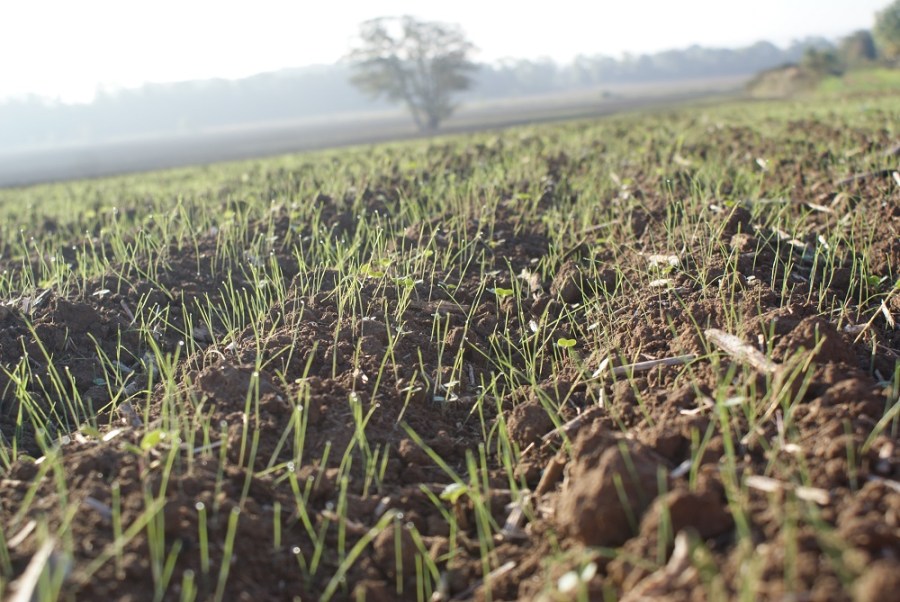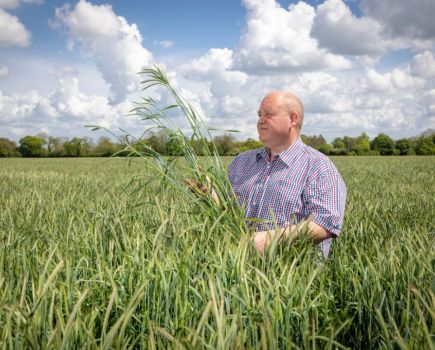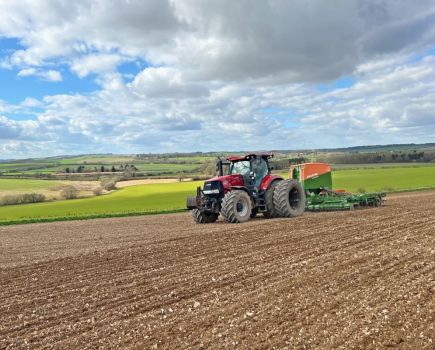The responsible use of herbicides required to control yield and quality robbing weeds is a key component to maintaining the gross margin potential of cereal crops. DuPont plays a pivotal role in helping growers reach that potential and so is keen to support the most recent Tech Talk.
Broader approach to weed control
Some broadleaf weeds are even more competitive than grassweeds. CPM finds out how both types can be controlled using the herbicide stack.
Broadleaf and grassweed control go hand-in-hand.
By Lucy de la Pasture
When it comes to blackgrass control most growers set out with a clear strategy in mind, using both cultural and chemical controls. Every little addition to overall control helps in reaching the ultimate goal of 97%, which is needed to manage seed return.
With eyes firmly fixed on grassweed control, it’s easy to forget that some broadleaf weeds are ranked in the same category as blackgrass when it comes to their ability to be competitive with the crop. Black bindweed, charlock, common poppy, creeping thistle and scentless mayweed all fall into the same competitive category as blackgrass. While it’s a numbers game where the relative importance of weeds is concerned, broadleaf weed control remains an important part of an overall herbicide strategy.
ADAS weed scientist Dr Sarah Cook and DuPont’s Alister McRobbie give some essential advice on weed control strategies.
Why apply an autumn residual herbicide?
Broadleaf and grassweed control go hand-in-hand, with many of the herbicides commonly used as part of the residual herbicide stack for blackgrass control also having some effect on broadleaf weeds.
Weeds emerge at different times and the interaction between weed and crop growth is important, most problems occur when weeds and crops emerge at the same time.
A pre-emergence or early post-emergence autumn herbicide can help get the crop off to a good start by removing potentially competitive weed species while they are still small. Any susceptible weeds that aren’t killed outright will be sensitised to subsequent post-emergence herbicide applications.
Many broadleaf weeds are also very susceptible to competition, especially at the early growth stages, and a strongly competitive crop will assist other control measures and may negate the need for a follow-up application in the spring.
Resistance to the pre-emergence herbicides used for grassweed control tends to be only partial and builds up relatively slowly, so they appear to be a lower resistance risk than most post-emergence options.
Which are the target weeds?
Many broadleaf weed species emerge at specific periods of the year. Some tend to be autumn germinators, for example cleavers, volunteer oilseed rape, cranesbill, parsley piert, poppy, scentless mayweed, ivy-leaved speedwell and charlock, while others emerge in the spring; black bindweed, black nightshade, fat-hen, fools parsley, hemp-nettle, knotgrass, redshank and scarlet pimpernel.
Other weed species germinate in both autumn and spring, including common species such as chickweed, common field-speedwell, field pansy, fumitory, groundsel and shepherd’s purse.
Some broadleaf weeds are becoming increasingly problematic on farm, with the umbelliferous weeds, bur chervil (hedge parsley) and wild carrot, increasing and being typically reported not only on sandy soils but also on some heavier soil types. They’re a problem because very few control options are available and they’re very competitive weeds.
What about grassweeds?
Grassweeds are bound to take precedence on most farms, but control strategy should complement broadleaf weed control. The principles are the same, early removal of competition while weeds are small, so consider broadleaf weeds even when the primary target is blackgrass.
Pre-emergence residual herbicides are the most valuable component of a chemical blackgrass control strategy, providing moderate to high levels of efficacy, even against target site (ALS and ACCase) resistant blackgrass.
Resistance to residual herbicides tends to develop slowly relative to that for post-emergence herbicides, so even when some enhanced metabolism resistance (EMR) is present, they can still provide useful control.
So while a pre-emergence flufenacet is the keystone to herbicide programmes, adding herbicides with different modes of action to the ‘stack’ adds a few more percentage points of control.
How do you reduce the weed seed burden?
The foundation of all good weed control is managing the seed-bank. The prevention of seed return is particularly important as most broadleaf weeds produce seeds that are much more persistent than grassweed seeds.
For many broadleaf weed species, there’s virtually no opportunity for depleting the seedbank prior to drilling a crop in early or late autumn (see table below). These weeds emerge over longer periods, sometimes in autumn but also in spring. Even if good control is achieved, the seeds are persistent and can emerge in future years.

There’s a moderate chance in depleting scentless mayweed, chickweed, Ivy leaf and field speedwells, and field pansy seeds from the seedbank. All have peaks of emergence in the spring and autumn and cultivations help to deplete weed seeds by between 41-62% annually.
A fallow year offers a limited opportunity to deplete the weed seed-bank of many species. Of the broadleaf weeds, this approach gives a moderate chance of reducing cleaver seeds as they have a shorter persistence than other weeds (2-3 years) and a peak germination period in Oct and Nov.
Two species of broadleaf weeds, poppy and fat hen, are difficult to deplete, even after a full year of fallow. These species have a very high level of seed production and a long persistency, poppy seed surviving for 50 years or longer in the soil.
Cultivations can stimulate emergence and delaying drilling will give time for control of germinated weeds. Repeated cultivations have only been shown to deplete poppy and fat hen populations by 31-32% annually.
What works best for the pre-em herbicide?
Delayed drilling is a useful tactic for both broadleaf weeds and grassweeds as the number of weeds emerging becomes less as autumn drilling becomes later. The cooler conditions and improved soil moisture that occur later in the autumn period means that residual herbicides also work better.
Firm, moist and clod-free seedbeds are essential to get the best performance from pre-emergence herbicides, where good soil coverage is all important. For many pre-emergence herbicides, cereal seeds need to be covered by 32mm of settled soil.
Application is advisable as soon as possible after drilling for best efficacy, avoiding spraying when soil conditions are very dry.
What should you add to the stack?
With its efficacy being little affected by resistance, flufenacet is the cornerstone of the herbicide stack, typically giving up to 80% control of blackgrass pre-emergence.
Other residual active ingredients added to the stack, such as flupyrsulfuron (FPU) diflufenican (DFF), flurtamone, pendimethalin, prosulfocarb and tri-allate provide additional levels of control to the flufenacet base. FPU consistently adds 15-20% control to a flufenacet base in blackgrass programmes, according to results from 78 trials over five years.
FPU also has the advantage of a broad spectrum of activity against broadleaf weeds, including difficult to control species such as wild carrot and bur chervil (see table below) at 20g/ha and when weeds are small. For wild carrot control, FPU plus DFF is more effective than FPU used alone.
DuPont trials have shown that when Avadex and FPU are used pre-emergence of the blackgrass, FPU dramatically reduces the variability of control which is seen with Avadex when used alone. The use of several herbicides with different modes of action is useful for resistance management, as well as improving the spectrum of weed control.

What about spring weed control and sequencing SU’s?
Follow-up spring weed control may be necessary where autumn-treated weeds haven’t been fully controlled or new weeds have emerged. The herbicide selected will be dependent on the species of weeds present in the spring, but is often based around a sulfonylurea (SU) herbicide.
Generally, only two applications of SU herbicides are allowed and sequencing restrictions are dependent on individual product labels and tank-mixes. For the most up-to-date information check the DuPont ALS-sequence app for legality before applying.
FPU critical part of winter barley stack
Growing winter barley is no longer an option for many arable farmers where significant blackgrass populations are encountered, despite the crop’s ability to compete, according to Glos-based independent AICC agronomist Jonathan Olver.
“Our winter barley acreage has declined significantly and been replaced by spring barley,” he says.
“Where we can delay drilling in a wheat crop to good advantage in Oct, agronomically winter barley is far better drilled in late Sept. If aggressive and high populations of blackgrass exist, then it’s a far harder job to achieve even adequate control with the limited post-emergence options.”
Where Jonathan’s clients are still able to grow winter barley without the threat of blackgrass dramatically reducing yield to unsustainable levels, the whole herbicide programme relies on getting maximum efficacy from a stack of actives applied pre-emergence.
“If we’ve made the decision to grow winter barley then the herbicide strategy has to be incredibly robust and able to deliver at least 95% control. If that’s not the case, then spring barley is the only option under those circumstances,” he says.
An application of Avadex (triallate) granules followed by either Crystal (flufenacet+ pendimethalin) or Liberator (flufenacet+ DFF), plus Defy (prosulfocarb) or Lexus SX (flupyrsulfuron) is essential in order to control blackgrass at a sustainable level that winter barley can happily compete with.
“In those situations where there might only be a slight problem with blackgrass, then this ‘belt and braces’ approach works very well. For modest levels, then including FPU in the mix can boost control significantly.
“Phytotoxicity can be a real issue with winter barley and that’s why the focus is primarily on a pre-emergence treatment. FPU, of course, must be applied pre-emergence to barley anyway, but if conditions are right, then in combination with flufenacet and DFF the results can be very encouraging.”
Jonathan insists on Avadex paving the way for the subsequent pre-emergence herbicide. FPU then complements the mix, being kinder to the crop overall than perhaps other herbicides that can be used in the same application slot.
Coupled with the blackgrass control FPU offers, he also highlights the benefits of dealing with populations of broadleaf weeds, such as volunteer OSR and cranesbill, and the way FPU compliments the spectrum offered by DFF and PDM.
“Effective control early on in the crop’s life is key to achieving target yield,” he adds. “Post-emergence control is unfortunately no longer a viable option and if we can suppress the emerging weeds successfully, both blackgrass and broadleaf weeds, then we have a chance of success.
“FPU is integral to that success and in winter barley, it’s a far easier decision to make than in the wheat crop. You could say it’s a ‘no brainer’. Having said that, I rigorously monitor crops for signs of an increase in the blackgrass population and if the criteria are met, then I advise growers still wanting to grow barley to switch to spring drilling.”
Getting the best from autumn weed control: top tips
- Apply pre-emergence – FPU can add 15-20% to flufenacet for blackgrass control.
- Use different modes of action – to reduce selection pressure for resistance to herbicides.
- Consider broadleaf weeds – FPU offers a broad spectrum of weed control, including difficult to control weeds.
Sponsor message
The challenge in keeping on top of blackgrass plus troublesome autumn broadleaf weeds is to make best use of the tools available in your chemical armoury. Drawing on most recent research and practical field experience, the inclusion of FPU in an autumn programme serves as a cost-effective boost to blackgrass control pre-emergence, and removes the majority of broadleaf weeds including cranesbill, mayweed, volunteer oilseed rape, charlock, bur chervil, groundsel and chickweed.




